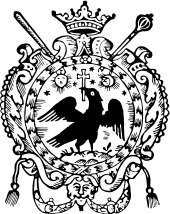Principality of Wallachia
The principality of Wallachia ( Romanian principatul Țării Româneşti ) was a state with the center in Câmpulung and later in Curtea de Argeş , which arose at the beginning of the 14th century under Prince Basarab I. Until 1330 the principality was under the supremacy of the Kingdom of Hungary , the year of the Battle of Posada , in which King Charles of Hungary was militarily defeated by the Wallachians .
history
As a result of the complete Ottoman conquest and annexation of Bulgaria by 1396, Wallachia bordered the state of the Ottoman sultans and, despite the bitter resistance of Prince Mircea the Elder to Sultan Bayezid I, after the battles of Rovine in 1395 and Nicopolis in 1396, became dependent on the Ottoman Empire . An exact point in time for the beginning of the dependency relationship between the Wallachians and the Ottomans can hardly be determined, as it was a step-by-step process that was never regulated in a binding manner. At the beginning there were isolated, later regular tribute payments to maintain the peace. The voivods viewed the payment of tributes as a levy to buy peace, while the Ottoman side interpreted this as submission to the supremacy of the sultan. Tribute payments had to be made to the Sultan's court in Edirne and, from 1453, in Constantinople , which over the centuries secured the internal autonomy of the state and also prevented a violent conquest and Islamization of the principality. After the political overthrow of Prince Vlad III. In 1462, however, Drăculea consolidated its political dependence on its neighbors in the south. Due to the weakness of the rulers and internal power struggles within the boyar oligarchy , the principality became a de facto vassal state of the Ottoman Empire in the following centuries , whereby the Wallachian princes, also entitled Voivode or Hospodar , were obliged to serve in the Ottoman army in addition to paying tribute were. At the turn of the 16th and 17th centuries, thanks to a weak phase in the Ottoman Empire, Wallachia and other Ottoman protective states in the region briefly regained their independence . The Principality of Wallachia was united with the Principality of Transylvania and the Principality of Moldova for the first time in 1600 as part of a nearly one-year personal union under Prince Michael the Brave . The Danube cities of Giurgiu and Turnu Măgurele (from 1417) and Brăila (from 1538) were under direct Ottoman rule until 1829.
The unification with the Principality of Moldova in 1859 was the origin of the Principality of Romania , which was proclaimed on December 24, 1861 and is considered the successor of both states.
coat of arms
Blazon : ". In blue on the left of turned, auffliegender, back-sighted, silbernbekrallter, black eagle, an uprooted deciduous tree in natural colors in the claws and a golden Fußspitzenkreuzchen in its beak, in chief beseitet front of a golden rays sun behind by a silver crescent moon" - "On the edge of the shield a prince's hat made of ermine cuff with five visible semicircular bibs , three visible (four) golden rays that converge in the middle and are studded with silver pearls, in the middle with a small blue orb with golden fittings and a cross and a purple cap underneath. "
gallery
See also
literature
- Steven W. Sowards: Modern History of the Balkans. The Balkans in the age of nationalism. BoD 2004, ISBN 3-8334-0977-0 .
- Daniel Ursprung: Wallachia as a historical region - the interface of European interdependencies on the periphery. In: Romania: Space and Population. History and images of history. Culture. Society and politics today. Economy. Law and constitution. Historic regions. Edited by Thede Kahl, Michael Metzeltin, Mihai Răzvan Ungureanu . Lit Verlag, Vienna / Münster 2006. pp. 807–824 (also special volume of the Österreichische Osthefte - Journal for Central, East and Southeast European Research, 48/2006), ISBN 3-8258-0069-5 and ISBN 3-7000-0593 -8 .
References and comments
- ^ Gerhard Ernst: Romance language history. P. 736
- ^ Ebba Hagenberg-Miliu, Ebba-Christina Hagenberg-Miliu: Romania. P. 38
- ↑ according to Brigitta Gabriela Hannover: Bucharest. P. 28, from 1396 tribute payments and recognition of sovereignty, according to Ebba Hagenberg-Miliu, Ebba-Christina Hagenberg-Miliu: Romania. P. 38, not until 1415 tribute obligation including vassal oath; according to Daniel Ursprung: legitimation of power between tradition and innovation. P. 41, from 1415/17 only regular tribute payments without vassal oath
- ↑ Daniel Ursprung: Legitimation of power between tradition and innovation. P. 41
- ↑ Klaus Kreiser: The Ottoman State 1300-1922. P. 21
- ↑ Viorel Panaite: Ottoman Law of War and Peace: The Ottoman Empire and Its tribute payers from the North of the Danube , p 110
- ↑ Birgitta Gabriela Hannover Moser: Romania: Art treasures and natural beauties , p. 303
- ^ Robert S. Rush and William W. Epley: Partnership for Peace. Consortium of Defense: Multinational Operations, Alliances, and International Military Cooperation Past and Future , Vienna, 2005, p. 14; Roumen Dontchev Daskalov and Tchavdar Marinov: Entangled Histories of the Balkans - Volume One: National Ideologies and Language Policies , 2013, p. 84
- ↑ Wolfgang Kessler: East and Southeast German Homeland Books and Ortmonographien after 1945 , p. 285
- ↑ Arbeitsgemeinschaft Ostdeutscher Familienforscher: Guide for research into ancestors from the East German and Sudeten German areas as well as from the German settlement areas in Central, Eastern and Southeastern Europe , p. 128


